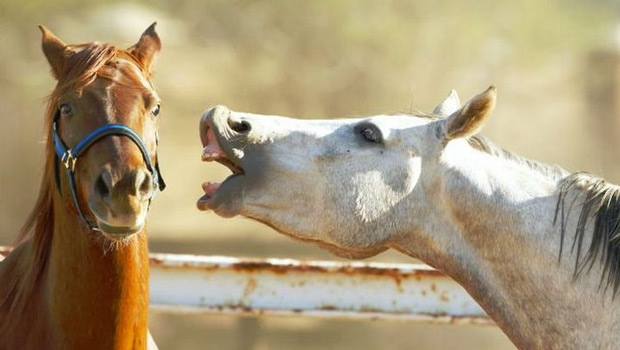The horse's 'sniffing' contains their happy feelings?
Do you still see the horses sniffing even for no reason? The hidden cause of that sniff turned out to be how horses are expressing their happy or sad feelings.

We all know that horses convey a lot of information through their ears and eyes. However, according to a recent study by French scientists, the horse's snort is actually a way of conveying their emotions.
According to research conclusions, the sound of snorting is likely to represent the happy and peaceful state of a horse.
The team of scientists at the University of Rennes, France, conducted research on 48 horses divided into 3 groups. In it, two groups were released in grasslands to be surrounded and fed with grass blocks. The other group was released on a large, unrestricted meadow.
According to Mother Nature Network, they observed horses snorting when they were in a positive state, on a meadow. Two groups of horses kept in the barn sniffed twice as they were released in the pasture. Even the horses sniff 10 times more when they are released on grasslands with new food sources. There is no difference in the rate of sneezing between male and female horses or their age.
Alban Lemasson, a physiologist from Rennes University and co-author of the study shared with Gizmodo: "Being isolated for a long time is not what horses enjoy. They like to eat grass for hours. "The horse also likes to go for a walk outside. Being locked in a cage for hours seems to be uncomfortable for them."
The video shows a horse sniffing when it is launched to walk outside the field.
In another study, scientists from the Department of Welfare and Animal Ethics at the ETH Zurich Institute of Agricultural Sciences, Switzerland, discovered that every horse can create two independent frequencies. Each frequency transmits information about the different emotions of the horse.
Lead researcher Elodie Briefer shared: "Each frequency indicates positive or negative emotions, while some frequencies clearly show the power of emotions."
To get these interesting findings, the researchers had to test on 20 different horse groups by putting them in a series of positive and negative situations. Later, they used cameras and microphones to record each horse's reaction when a horse was removed from the group and after returning it. The team also measured the heart rate, breath and skin temperature of each horse for the purpose of decoding the sound they still communicate with each other.

Based on research findings, positive emotions often come with a shorter whin. The sound frequency in the low-pitched voices is also lower and the horse also often lowers the head. When you want to convey negative emotions, the sound will be longer and the sound frequency is higher.
In addition to grasping what emotions are negative and positive, researchers can assess the intensity of each emotional state. By calculating factors such as high rates of respiration, body movement and low frequency in the hoof of the horse, the team can assess their emotional intensity.
Even so, the scientific community has yet to figure out how horses produce these two basic frequencies. They only hypothesize, they create two forms of neural through a form of asynchronous vibration of vocal cords.
Anyone who has ever taken care of a horse knows that the horse's hoot can be high, low and sometimes the voice is based on the situation that the horse faces.
Swiss scientists believe that this useful information will help horse riders and veterinarians better understand the behavior of a horse, thereby taking better care of them.
The study is part of the scientists' project to consider domestication effects. They are learning how to express the emotions of domesticated animals and how different wildlife are.
- Horses know how to read people's emotions
- Faith helps people to be happy
- Ambition to create a race of asexual horses
- The wild horse Przewalski echoes the prairie
- Interesting facts about horses
- Small horses like ... cats
- Interesting things of horses
- Wild horses
- Why do horses often sleep?
- Believing in hell makes us less happy
- Scientific aspect of happy relationship
- Why does soccer make people happy?
 Animal 'suffering' after hibernation
Animal 'suffering' after hibernation Why do goats climb well?
Why do goats climb well? Scientists were surprised to see chimpanzees eating turtles
Scientists were surprised to see chimpanzees eating turtles Giant catfish died deadly due to drought in Thailand
Giant catfish died deadly due to drought in Thailand Horse Diving: A Dangerous, Cruel Sport in the 19th Century
Horse Diving: A Dangerous, Cruel Sport in the 19th Century  Top 4 legendary war horses recorded in history books
Top 4 legendary war horses recorded in history books  Illusion video causes netizens to debate: Is the horse moving closer or farther away?
Illusion video causes netizens to debate: Is the horse moving closer or farther away?  4 Challenges Every Horse Enthusiast Must Know Before Getting a Horse
4 Challenges Every Horse Enthusiast Must Know Before Getting a Horse  Akhal-Teke - The most beautiful horse in the world, with red sweat like blood
Akhal-Teke - The most beautiful horse in the world, with red sweat like blood  The Trojan Horse: Real or Legendary?
The Trojan Horse: Real or Legendary? 